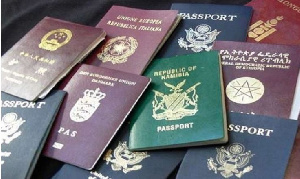How the European Union is rolling out biometric national ID cards for travel just as Ghana

Following the declaration by Vice President Dr. Mahamudu Bawumia that the Ghanacard will soon become an e-passport for Ghanaians, it has emerged that the European Union has also commenced processes to turn their national ID cards into an electronic passport for EU citizens, reports tech giants DID Global.
At his public lecture on digitization at Ashesi University last week, Dr. Bawumia revealed that the government has already initiated processes with the International Civil Aviation Organization (ICAO) for the Ghanacard, which has unique biometric features, to be recognised by ICAO globally as an e-passport, especially for Ghanaians returning home, and a full e-passport moving forward.
Just as Ghana, EU member states have commenced processes to turn their national IDs as e-passports, in compliance with Regulation (EU) 2019/1157, which requires its 450 million citizens and approximately 20 million non-EU citizens, who reside or work in the member states, to be equipped with safe, secure and reliable identification.
It is estimated that over a billion people travel within the European Union (EU) or crossed its external borders every year, and this spurred the new regulation that prompted strict and consistent identification measures designed to accurately verify and validate citizen identity to ensure ease of mobility between member states, while limiting terrorism and organized crime.
Moreover, member states have agreements with several third-party countries, allowing EU citizens to travel using those same national identity cards.
As part of the regulation, existing national ID card formats of EU member states must be phased out within five years of August 2021. Cards that are not machine-readable will be phased out within two years from the date of application of the regulation, giving countries time to address the security gaps as quickly as possible.
The e-passport
The case for using biometrics for identification at international borders is well established.
Countries and states are already using the technology to monitor who passes through their borders, while vastly decreasing processing time, allowing more travelers to pass through quickly, reducing staff labor and increasing traveler satisfaction.
The e-passport is a form of advancing the process a step further.
What’s Next?
Clearly the use of biometric two-finger and facial image enrollment for a national ID card is a step up from having to carry and produce passports for travel and border access for numerous reasons, including speed, convenience, advanced security and fraud detection.
These national ID cards are not confined to travel, however. With EU’s eIDAS mandate, the same ID documents already help businesses, citizens and public authorities carry out secure and seamless electronic interactions in use cases such as:
Access to public documents, such as birth certificates, medical certificates or reporting a change of address, filing tax returns, opening a bank account or applying for a loan, accessing or storing medical records and prescriptions, verifying age , facilitating travel, such as renting a car or checking into a hotel.
As a next step, the European Commission wants to develop an app that would contain the digital version of the national ID card — the “wallet” — which they’ll start testing in October of 2021. Some visionary countries are also implementing mobile or eIDs now, for even more convenience.
The EU national ID regulation is bringing us one step closer to biometric identity standardization for a truly global community — not just for travel but for secure access to all the things that make our lives easier.
Interestingly, the Ghanacard, already has all the features most EU member nations are now trying to integrate into their national cards.
Source: ghanaguardian.com






